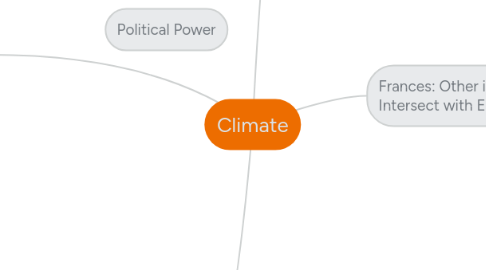Climate
por Audrey Stuart


1. Social Vulnerability to Climate Change in Peripheral Nations
1.1. Descriptive: What are the various definitions of social vulnerability? What are the different indices used to measure social vulnerability? How will effects of climate change such as drought, saltwater intrusion, and extreme storm events change in peripheral countries? What are key patterns of development in peripheral countries that will affect social vulnerability? What specific populations and livelihoods will be most affected by climate change?
1.2. Explanatory: What economic factors and power structures make periphery nations most vulnerable to climate change?
1.3. Evaluative: In what ways could the social vulnerability of peripheral nations be a concern for the world as a whole? How have rapid growth, unsustainable infrastructure, and inequality increased social vulnerability in peripheral nations?
1.4. Instrumental: How can peripheral nations build their adaptive capacity? How have changes in infrastructure increased or decreased social vulnerability? What should the roles of governments and non-state groups be? What is the most effective way to allocate funds and make sure resources are effectively used in regions with the highest vulnerability? Why have efforts to reduce social vulnerability not been effective?
2. Political and Technological Solutions to Future Water Quality and Supply Issues in the American West
2.1. Agriculture
2.2. Drinking/Household Water
2.3. Fish (salmon)
2.4. Hydropower
3. Development
4. Political Power
5. Extreme weather events
6. Poverty
7. Descriptive: What are some of the main uses of water in the American west? What sources does water come from, and how have humans changed these water sources in order to better control over water supply? Have any major water systems already changed aspects of their management in order to better prepare for the future?
8. Explanatory: How are water supply managers in the American West expecting drought to affect water quality and supply? How are they planning to respond to future issues with water supply? How will interstate water politics shape responses to water supply?
9. Evaluative: Who would be affected by the creation of bigger water storage reservoirs? Can we increase our resilience to climate changes and still take into account the needs of fish? Will there be enough water for agricultural uses, household uses, hydropower and aquatic ecosystems? How will water needs be prioritized among these stakeholders?
10. Instrumental: How can we use water law to ensure that we meet water demands for agricultural, drinking water, power supply and ecological needs? How can we use policy and technology to decrease agricultural and household water demand in arid regions? Concentration courses
11. The Politics of Greenhouse Gas Emission Reduction in G20 Nations
11.1. Descriptive: What strategies are G20 nations using to reduce greenhouse gas emissions? What resistance is there to these strategies? What tensions are there between members of the G20?
11.1.1. what strategies
11.1.2. what resistance
11.1.3. what tensions
11.2. Explanatory: Why do some G20 nations prioritize reducing emissions more than others? Why is there resistance to the strategies for reducing emissions?
11.2.1. why prioritize
11.2.2. why resist
11.3. Evaluative: How does the effectiveness of G20 greenhouse gas initiatives change in the long, medium, and short terms? How does the effectiveness greenhouse gas initiatives change when the G20 is taking collective vs. individual action?
11.3.1. effectiveness: long, medium, short terms
11.3.2. effectiveness: individual vs. collective action
11.4. Instrumental: What role can the G20 play in initiating international collective action to reduce greenhouse gas emissions? How can the G20 effectively reduce global greenhouse gas emissions?
11.4.1. role in initiating collective action
11.4.2. how can it be effective
